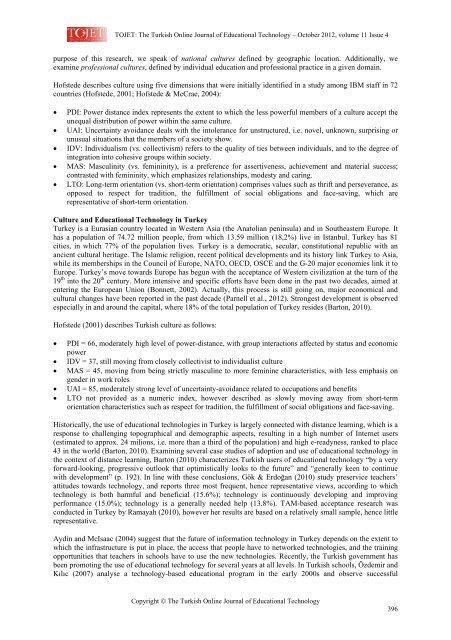october 2012 - TOJET the Turkish online journal of educational ...
october 2012 - TOJET the Turkish online journal of educational ...
october 2012 - TOJET the Turkish online journal of educational ...
You also want an ePaper? Increase the reach of your titles
YUMPU automatically turns print PDFs into web optimized ePapers that Google loves.
<strong>TOJET</strong>: The <strong>Turkish</strong> Online Journal <strong>of</strong> Educational Technology – October <strong>2012</strong>, volume 11 Issue 4<br />
purpose <strong>of</strong> this research, we speak <strong>of</strong> national cultures defined by geographic location. Additionally, we<br />
examine pr<strong>of</strong>essional cultures, defined by individual education and pr<strong>of</strong>essional practice in a given domain.<br />
H<strong>of</strong>stede describes culture using five dimensions that were initially identified in a study among IBM staff in 72<br />
countries (H<strong>of</strong>stede, 2001; H<strong>of</strong>stede & McCrae, 2004):<br />
• PDI: Power distance index represents <strong>the</strong> extent to which <strong>the</strong> less powerful members <strong>of</strong> a culture accept <strong>the</strong><br />
unequal distribution <strong>of</strong> power within <strong>the</strong> same culture.<br />
• UAI: Uncertainty avoidance deals with <strong>the</strong> intolerance for unstructured, i.e. novel, unknown, surprising or<br />
unusual situations that <strong>the</strong> members <strong>of</strong> a society show.<br />
• IDV: Individualism (vs. collectivism) refers to <strong>the</strong> quality <strong>of</strong> ties between individuals, and to <strong>the</strong> degree <strong>of</strong><br />
integration into cohesive groups within society.<br />
• MAS: Masculinity (vs. femininity), is a preference for assertiveness, achievement and material success;<br />
contrasted with femininity, which emphasizes relationships, modesty and caring.<br />
• LTO: Long-term orientation (vs. short-term orientation) comprises values such as thrift and perseverance, as<br />
opposed to respect for tradition, <strong>the</strong> fulfillment <strong>of</strong> social obligations and face-saving, which are<br />
representative <strong>of</strong> short-term orientation.<br />
Culture and Educational Technology in Turkey<br />
Turkey is a Eurasian country located in Western Asia (<strong>the</strong> Anatolian peninsula) and in Sou<strong>the</strong>astern Europe. It<br />
has a population <strong>of</strong> 74.72 million people, from which 13.59 million (18,2%) live in Istanbul. Turkey has 81<br />
cities, in which 77% <strong>of</strong> <strong>the</strong> population lives. Turkey is a democratic, secular, constitutional republic with an<br />
ancient cultural heritage. The Islamic religion, recent political developments and its history link Turkey to Asia,<br />
while its memberships in <strong>the</strong> Council <strong>of</strong> Europe, NATO, OECD, OSCE and <strong>the</strong> G-20 major economies link it to<br />
Europe. Turkey’s move towards Europe has begun with <strong>the</strong> acceptance <strong>of</strong> Western civilization at <strong>the</strong> turn <strong>of</strong> <strong>the</strong><br />
19 th into <strong>the</strong> 20 th century. More intensive and specific efforts have been done in <strong>the</strong> past two decades, aimed at<br />
entering <strong>the</strong> European Union (Bonnett, 2002). Actually, this process is still going on, major economical and<br />
cultural changes have been reported in <strong>the</strong> past decade (Parnell et al., <strong>2012</strong>). Strongest development is observed<br />
especially in and around <strong>the</strong> capital, where 18% <strong>of</strong> <strong>the</strong> total population <strong>of</strong> Turkey resides (Barton, 2010).<br />
H<strong>of</strong>stede (2001) describes <strong>Turkish</strong> culture as follows:<br />
• PDI = 66, moderately high level <strong>of</strong> power-distance, with group interactions affected by status and economic<br />
power<br />
• IDV = 37, still moving from closely collectivist to individualist culture<br />
• MAS = 45, moving from being strictly masculine to more feminine characteristics, with less emphasis on<br />
gender in work roles<br />
• UAI = 85, moderately strong level <strong>of</strong> uncertainty-avoidance related to occupations and benefits<br />
• LTO not provided as a numeric index, however described as slowly moving away from short-term<br />
orientation characteristics such as respect for tradition, <strong>the</strong> fulfillment <strong>of</strong> social obligations and face-saving.<br />
Historically, <strong>the</strong> use <strong>of</strong> <strong>educational</strong> technologies in Turkey is largely connected with distance learning, which is a<br />
response to challenging topographical and demographic aspects, resulting in a high number <strong>of</strong> Internet users<br />
(estimated to approx. 24 milions, i.e. more than a third <strong>of</strong> <strong>the</strong> population) and high e-readyness, ranked to place<br />
43 in <strong>the</strong> world (Barton, 2010). Examining several case studies <strong>of</strong> adoption and use <strong>of</strong> <strong>educational</strong> technology in<br />
<strong>the</strong> context <strong>of</strong> distance learning, Barton (2010) characterizes <strong>Turkish</strong> users <strong>of</strong> <strong>educational</strong> technology “by a very<br />
forward-looking, progressive outlook that optimistically looks to <strong>the</strong> future” and “generally keen to continue<br />
with development” (p. 192). In line with <strong>the</strong>se conclusions, Gök & Erdoğan (2010) study preservice teachers’<br />
attitudes towards technology, and reports three most frequent, hence representative views, according to which<br />
technology is both harmful and beneficial (15.6%); technology is continuously developing and improving<br />
performance (15.0%); technology is a generally needed help (13.8%). TAM-based acceptance research was<br />
conducted in Turkey by Ramayah (2010), however her results are based on a relatively small sample, hence little<br />
representative.<br />
Aydin and McIsaac (2004) suggest that <strong>the</strong> future <strong>of</strong> information technology in Turkey depends on <strong>the</strong> extent to<br />
which <strong>the</strong> infrastructure is put in place, <strong>the</strong> access that people have to networked technologies, and <strong>the</strong> training<br />
opportunities that teachers in schools have to use <strong>the</strong> new technologies. Recently, <strong>the</strong> <strong>Turkish</strong> government has<br />
been promoting <strong>the</strong> use <strong>of</strong> <strong>educational</strong> technology for several years at all levels. In <strong>Turkish</strong> schools, Özdemir and<br />
Kılıc (2007) analyse a technology-based <strong>educational</strong> program in <strong>the</strong> early 2000s and observe successful<br />
Copyright © The <strong>Turkish</strong> Online Journal <strong>of</strong> Educational Technology<br />
396
















